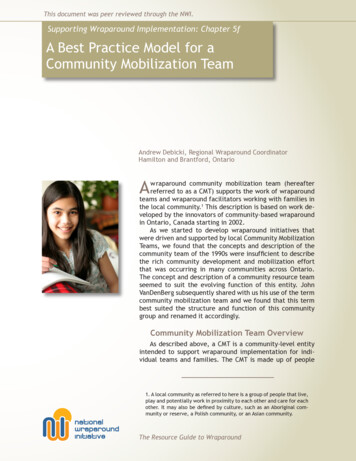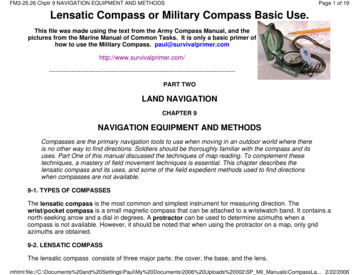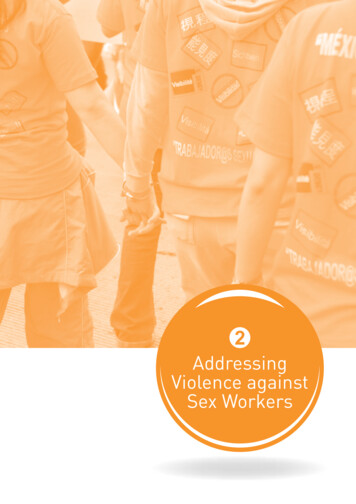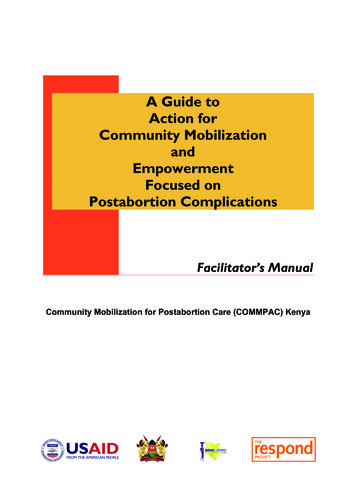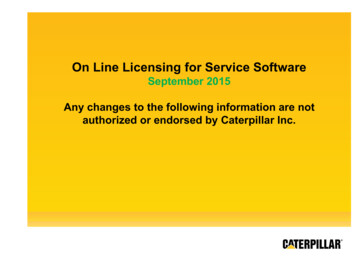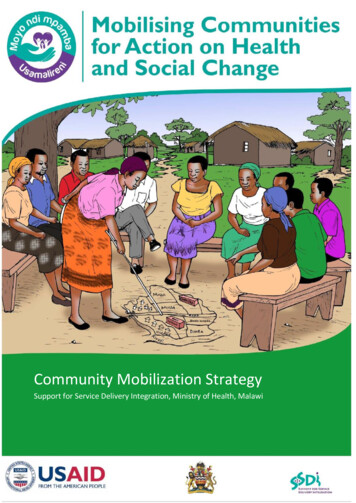
Transcription
Community Mobilization StrategySupport for Service Delivery Integration, Ministry of Health, Malawi1
Table of ContentsCONTENTS . 2ACKNOWLEDGEMENTS .3FOREWORD . . .5LIST OF ABBREVIATIONS . 61.1 Support for Service Delivery Integration (SSDI) - Communication . 81.2 Mobilizing communities for improved health . 81.3 Users of the Community Mobilization Strategy . 81.4 Background: Malawi’s health system . 81.5 Governance structure of the health system in the districts . 91.6 Malawi’s Health Sector Strategic Plan . 101.7 The SSDI consortium . 102.1 The process of developing the strategy . 122.2 What is Community Mobilization? . 122.3 Community Mobilization approaches already in use in Malawi . 132.4 Objectives of Community Mobilization . 142.5 EHP priorities to be addressed by CM . 142.6 Structures to be used for Community Mobilization . 152.7 Community Action Group . 153.0 THE COMMUNITY ACTION CYCLE – A STEP-BY-STEP PROCESS FOR IMPROVINGCOMMUNITY HEALTH.173.1 Outline of the CAC. 173.2 Steps in the Community Action Cycle . 183. Explore the health issues and set priorities . 215. Act together . 226. Evaluate community health activities together . 234.0 HOW WILL SSDI IMPLEMENT THE STRATEGY? .234.1 SSDI’s participatory approach . 234.2 Sustainability . 244.3 SSDI staff at national, zonal, and district levels . 24National Level: SSDI-Communication and SSDI-Services . 24Zonal Level: SSDI-Communication and SSDI-Services . 24District Level: SSDI-Services . 254.4 Working through NGOs – expected coverage . 254.5 The role of NGO sub-grantees . 265.0 THE COMMUNITY MOBILIZATION ROADMAP – ROLES AND RESPONSIBILITIES .285.1 Outline of the CM Roadmap . 285.2 A national team of Master Trainers in CM . 295.3 Teams of District Community Mobilization Trainers and the District Health Promotion Subcommittee of the DEC . 295.4 Community Mobilization Teams (CMT) at the TA level . 305.5 Role of all TA and ADC members . 315.6 Role and responsibilities of HSAs and Health Centre staff members . 315.7 Roles and Responsibilities of the Community Action Groups (CAG) . 315.8 Roles and Responsibilities of Community Health Volunteers . 325.9 Roles for Care group Lead Mothers . 332
APPENDICES .34Appendix 1 .34Community mobilization results .34a. Milestones in the process. 34b. Expected outputs and indicators . 37c. SSDI Community indicators . 38Demographic indicators . 38Community Action Cycle indicators . 38EHP Specific indicators . 38Appendix 2 .40Budget requirements .403
ACKNOWLEDGEMENTSThe Ministry of Health in collaboration with SSDI Communication would like to thank thefollowing people and partner organizations for their various contributions and support towardsthe development of this strategy.The Ministry of Health is indebted to the United States Agency for International Development(USAID) for the financial assistance in the development and printing of this strategy.This work would not have come this far if it were not for the commitment and positivecontributions of the SSDI Community Mobilization Working Group of Cecilia Phiri (SSDIServices), Augustine Chikoko (SSDI Services), Hellen Dzoole Mwale (SSDI-Services), AustinMakwakwa (Health Education Unit), and Anna Chinombo (SSDI-Communication).Special thanks to the following government officials for providing advice and general guidanceduring the development of this CM strategy: the Ministry of Health (Director of SWAp; Directorof Preventive Health Services and Director of Planning); the Ministry of Local Government; theMinistry of Gender, Children and Community Services; the Ministry of Education and theMinistry of Agriculture.Sincere thanks go out to the following local NGOs for allowing the CM strategy developmentteam to learn about various community mobilization approaches currently in use in Malawi:Wellness and Agriculture for Life Advancement (WALA); Youth Net and Counselling (YONECO);Mai Khanda; Mai Mwana; CARE Malawi, Plan Malawi, BRIDGE II project; Concern Universal andMalawi Red Cross.Lastly, the Ministry of Health sincerely thanks the following experts for the moral support,encouragement, and technical guidance provided to the development of this strategy:Telesphore Kabore (Save the Children), Angela Brasington (Save the Children) Joby George(Save the Children); Fayyaz Ahmad Khan (SSDI-Communication), Jane Brown (JHU.CCP), AlinafeKasiya (SSDI-Communication), Chancy Mauluka (SSDI-Communication), Claire Slensiski(JHU.CCP), Amanda Manjolo (SSDI-Systems), Margaret Kambalame (BRIDGE II Project), DanWendo (SSDI-Services), Tambudzai Rashidi (SSDI-Services), Premila Bartlett (SSDI-Services),Hector Kamkwamba (Health Education Unit), Fannie Kachale (Reproductive Health Unit); JohnZoya (National Malaria Control Program); Tapiwa Nguluwe (Nutrition Section, MoH); MichaelEliya (HIV and AIDS Unit) Johnes Moyenda (SSDI-Communication), Jepther Mwanza (PlanMalawi), Tobias Kumkumbira (Health Education Unit), Hellen Dzoole (SSDI-Services), MavutoMizwa (SSDI- Communication), Adrian Misomali (Ministry of Local Government), Dr. WanangwaChisenga (Nkhotakota DHO), Edrine Sibande (Nkhotakota DHO), Traditional AuthoritiesMwadzama and Kanyenda of Nkhotakota.4
FOREWORDIn its quest to improve the health status of its people, the Government of Malawi is calling forthe strengthening of community engagement in health issues to make sure that communities ata grassroots level have a say about health related issues that concern them. CommunityMobilization (CM) is the preferred process that will help build the capacity of communities,individuals, groups, and organizations to better plan, implement, and evaluate activities on aparticipatory and sustained basis to improve their health.Community mobilization is a proven development strategy that has helped communitiesaround the world bring people together to identify and address pressing health-care issues. Itstrengthens and enhances the ability of the community to work together for any goal that isimportant to its members. The end result of a successful community mobilization effort is notonly a problem solved, but also the increased capacity to successfully address other communityneeds and desires.This Community Mobilization Strategy intends to provide direction on how to makecommunities participate fully and own the process of improving their health by using thecommunity action cycle (CAC). The strategy also provides a community mobilization roadmapand spells out roles and responsibilities of different players (stakeholders). In order to make theapproach sustainable, the strategy recommends using the already established decentralizedcommunity structures to implement the process.It is hoped that the guidance provided in this document will motivate many people to seekmore information on community mobilization and implement the community action cycle.Dr. Charles MwansamboSecretary for Health5
LIST OF EMoGCCDMoHMLGRDNCDNGONTDArea Development CommitteeArea Executive CommitteeAcquired Immune Deficiency SyndromeAntenatal CareAcute Respiratory InfectionAnti-Retroviral TreatmentBehaviour Change CommunicationCommunity Action CycleCommunity Action GroupCommunity Based Distribution AgentCommunity Based Information Management SystemCommunity Based OrganizationCommunity Health CommitteeCommunity Health VolunteerCommunity Health WorkerCommunity MobilizationCommunity Mobilization TeamDistrict CommissionerDistrict Executive CommitteeDistrict Health Management TeamDistrict Health Office(r)Demographic Health SurveyEssential Health PackageFamily PlanningGroup Village Head (man/woman)Home Based Care VolunteerHealth CentreHealth Education UnitHuman Immunodeficiency VirusHealth Surveillance AssistantHealth Sector Strategic PlanHIV Testing and CounsellingInformation, Education and CommunicationInsecticide Treated NetIntermittent Preventive Treatment in pregnancyJohns Hopkins University Center for Communication ProgramsLong Lasting Insecticide-treated NetMaternal and Child Health Integrated ProgramMaternal, Neonatal and Child HealthMinistry of Agriculture and Food SecurityMinistry of EducationMinistry of Gender, Children and Community DevelopmentMinistry of HealthMinistry of Local Government and Rural DevelopmentNon-communicable DiseaseNon-governmental OrganizationNeglected Tropical Disease6
HCWALAWASHWGWHOYGYONECOPrimary Health CarePrevention of Mother to Child Transmission (of HIV)Program of WorkReproductive HealthSocial and Behaviour Change CommunicationSocial engineering processScope of WorkSupport for Service Delivery IntegrationSector Wide ApproachTraditional AuthorityTuberculosisTraining of TrainersUnited States Agency for International DevelopmentUnited States GovernmentVillage Development CommitteeVillage Health CommitteeWellness and Agriculture for Life AdvancementWater, Sanitation and HygieneWomen’s GroupWorld Health OrganizationYouth GroupYouth Net and Counselling7
1.INTRODUCTION1.1 Support for Service Delivery Integration (SSDI) - CommunicationSSDI-Communication is a 5-year (2011–2016) Social and Behaviour Change Communication(SBCC) project, funded by USAID. The Center for Communication Programs at Johns HopkinsUniversity’s Bloomberg School of Public Health (JHU-CCP) implements the project in Malawi inpartnership with Save the Children and several local organizations.SSDI-Communication supports the Ministry of Health to focus on the following six priorityEssential Health Package (EHP) areas: reproductive health maternal, newborn and child health nutrition HIV/AIDS and tuberculosis water and sanitation family planning.SSDI-Communication developed this Community Mobilization Strategy under the leadership ofthe Ministry of Health’s Health Education Unit, using a participatory approach.1.2 Mobilizing communities for improved healthCommunity Mobilization (CM) is a specific approach for engaging communities to become theirown agents of change in order to make improvements in the health and well-being of theirfamilies and communities. The CM strategy therefore provides guidance on how to mobilizecommunities for improved health by setting up processes at various levels of the health systemand engaging the participation of stakeholders outside the health sector.1.3 Users of the Community Mobilization StrategyThe Community Mobilization Strategy is designed to be used by the following ministries: Ministry of Health (MoH) Ministry of Gender, Children and Community Development (MoGCCD) Ministry of Local Government and Rural Development (MLGRD) Ministry of Agriculture and Food Security (MoAFS) Ministry of Education (MoE).Also, other stakeholders at each level of the health system, such as non-government extensionworkers and Area Development Committee (ADC) members, will benefit from the strategy.The CM Strategy will serve as a daily guide for the Community Mobilization Teams (CMT) thatwill be formed and based at the Traditional Authority (TA) level in selected TAs. A CM Toolkitaccompanies the strategy.1.4 Background: Malawi’s health systemAbout 80 percent of Malawi’s population of over 13 million lives in rural areas where only basichealth-care services are provided. Most of the national disease burden has preventable causes,and contributing factors include low socio-economic status, low literacy, limited decisionmaking power among women, inadequate access to and utilization of essential health services,and cultural beliefs that lead to harmful practices.The health-care delivery system in Malawi is organized into three levels: Referral hospitals, known as the Central Hospitals, located in the 4 main urban areas.8
District hospitals (one in each district) provide most essential health-care services,including operations and caesarean sections; complicated cases are referred to centralhospitals. Health centres serve a catchment area of about 50 villages and populations of about20,000 people. They are staffed by nurses/midwives and medical assistants. Healthcentres provide basic preventative and curative services. Complicated cases at thehealth centre level are referred to district hospitals.Malawi has an acute shortage of health workers at all levels, making it difficult to provide careto the population, especially in the rural areas. A cadre of community health workers calledHealth Surveillance Assistants (HSAs) has been established and has assumed greaterresponsibilities over time. Each HSA is responsible for 1–4 villages with an average populationof 1,000 people, though the current national average population covered by HSAs is close to1,300. The HSAs deliver primary health care to all age groups, including mothers, newborns,and children; they also promote good preventative practices, such as improving water andsanitation facilities.1.5 Governance structure of the health system in the districtsMinistry of HealthDistrict Council / District CommissionerDistrict Executive Committee/District Development CommitteeMLGRDHealth SubCommitteeDistrict Health Management TeamArea Development CommitteeVillage DevelopmentCommitteesHealth Centre Management CommitteeHealth CenterAdvisoryCommitteeVillage Health CommitteesFigure 1: Governance structure of the health system in the districtsThere is one Area Development Committee (ADC) in each TA (Traditional Authority). The TApresides over this key committee, reporting back to the DC (District Commissioner). The TAsare subdivided into Group Village Headmen (GVH) who have jurisdiction over a number of9
Village Development Committees (VDC). Local development plans are developed at the VDClevel, consolidated at the ADC level, and then taken for approval as part of the DistrictDevelopment Plan.1.6 Malawi’s Health Sector Strategic PlanThe overall goal of the Health Sector Strategic Plan 2011–2016 (HSSP II) is to improve thequality of life of all the people of Malawi, thereby contributing to the social and economicdevelopment of the country. In 2004 Malawi introduced the Essential Health Package (EHP) t oensure universal coverage and cost-effective interventions to combat the main causes ofdisease. The DHS 20101 registers a number of achievements that have been made since 2004,such as: a reduction in the infant mortality rate from 76/1000 to 66/1000 a reduction in the under-five mortality rate from 133/1000 to 112 /1000 a reduced maternal mortality ratio from 984/100,000 to 675/100,000 an increase in women delivering at health centres from 57.2 percent to 73 percent an increase in the proportion of children with acute respiratory infections taken tohealth facilities for treatment from 19.6 percent to 70.3 percent. an increase in full immunization coverage among children aged 12–23 months from 55percent to 81 percent. Also, a reduction in pneumonia case fatalities has beenregistered, from 18.7 percent in 2000 to 5.7 percent in 2008.Despite all these achievements in public health, the numbers of women dying due to maternalcomplications and of children dying before their fifth birthday are still very high. Till recently,there has been an emphasis on facility level care, with very little done at the community level.In view of the fact that most of the causes of morbidity and mortality in Malawi arepreventable, the new HSSP (2011–2016) recommends the strengthening of communityinvolvement as one of its key pillars. Thus the Government of Malawi wants to ensure thatcommunities at a grassroots level can have a say and participate in issues that affect theirhealth.1.7 The SSDI consortiumThe Support for Service Delivery Integration (SSDI) project (1 October 2011–30 September2016) has been awarded US 100 million by USAID Malawi to support the Government ofMalawi in achieving its vision of improving the health status of all Malawians. In partnershipwith the Ministry of Health, SSDI supports effective integration and delivery of quality servicesunder the EHP, thus strengthening the national health system in line with the HSSP II.1Malawi Demographic Health Survey 2010.10
Figure 2: The SSDI ConsortiumThe SSDI project consists of three separate, but interrelated Co-operative Agreements inhealth: SSDI-Services supports the government to achieve improved service delivery SSDI-Systems supports the government to improve policies, management, andleadership SSDI-Communication supports social and behaviour change communication (SBCC) inhealth.SSDI is guided by the principles of country ownership and leadership, integration for greaterefficiency, and building on existing systems and past achievements. Its central theme is‘Together we build healthy families’.SSDI focuses on a comprehensive program of support in 15 districts (Nsanje, Phalombe,Chikhwawa, Machinga, Mangochi, Mulanje, Balaka, Zomba, Salima, Nkhotakota, Dowa,Kasungu, Lilongwe, Chitipa and Karonga) spread across the country’s five health zones.The international NGOs Save the Children International, CAREMalawi, and Plan Malawi arepartners in the SSDI Services Consortium. They themselves cannot be sub-contracted, but theywill sub-contract other NGOs to implement community mobilization in their SSDI focus districts.11
2.0THE COMMUNITY MOBILIZATION STRATEGY2.1 The process of developing the strategy1. SSDI-Communication held meetings in March and April 2012 with government partners(the Ministry of Health – Director of SWAp, Director of Preventive Health Services, andthe Acting Director-Health Education Unit; representatives from MLGRD and MoGCCD)to get their views on community mobilization for the Essential Health Package.2. Consultations were held with thetwoUSAID-fundedprojectsWALA(Wellness and Agriculture for LifeAdvancement) and BRIDGE II. The followingNGOs were also consulted: CARE Malawiand Plan Malawi (SSDI-Services’ partners);Concern Universal, Malawi Red Cross,YouthNet and Counselling (YONECO), andMai Khanda and Mai Mwana. All of theseorganizations are implementing on has learned from itsexperiences. The main areas of inquirywere: project focus, distinctive processesand platforms, and strengths andchallenges of each community mobilizationapproach.3. A working group was set up, composed of SSDI-Communication, SSDI-Services and theMoH Health Education Unit (HEU). This working group conducted field visits to threeprojects that have different community mobilization approaches (WALA, BRIDGE II, andPlan Malawi) to gain more insights for use as a basis for recommending best practices tobe adopted. The Working Group analysed findings and then drafted the SSDICommunity Mobilization Roadmap (see Chapter 5). This Community MobilizationStrategy was also drafted, and a meeting was held to invite input from stakeholders.2.2 What is Community Mobilization?Community Mobilization (CM) is defined2 as a process of building the capacity of communitiesto plan, carry out, and evaluate activities in a participatory and sustained way in order toimprove their health. CM aims to facilitate positive and sustainable changes in social norms andattitudes and also in individual, household, and community practices. CM is a proven approachto development that has helped people around the world identify and address pressing healthcare concerns. For instance, numerous studies have been published that demonstrate thepower of community mobilization to decrease newborn and maternal mortality3. The approachnot only helps people improve their health status and living conditions, but by its very nature it2Howard-Grabman L and Snetro G (2003), How to mobilize communities for health and social change – a healthcommunication partnership field guide. Baltimore: Health Communication Partnership.3Baqui et al. (2008), Effect of community-based newborn-care intervention package implemented through two service-deliverystrategies in Sylhet district, Bangladesh: a cluster-randomized controlled trial. Lancet (371): 1936–44.Kumar et al. (2008), Effect of community-based behavior change management on neonatal mortality in Shivgarh, Uttar Pradesh,India: a cluster-randomized controlled trial. Lancet (372): 1151–62.12
strengthens and enhances the ability of the community to work together for any goal that isimportant to its members. The end results of a successful community mobilization effort, inother words, are not only a ‘problem solved’ but also the increased capacity to solve otherproblems.This SSDI project defines ‘community’ as the population living under a Group Village Headman(GVH). In the Malawian context, this population will share a common language, ethnicity, andculture. This CM initiative therefore targets its activities at the GVH level.Principles of Community Mobilization Social change is more sustainable if the individuals and communities most affected own theprocess and content of behaviour-centred approaches; Communication for social change should be an empowering, horizontal (versus top-down)approach; CM should give voice to the previously unheard members of the community and be centred onlocal content and ownership; Parents, families, and communities should be the agents of change; Emphasis should shift from persuasion and the transmission of information from outsidetechnical experts to support for dialogue, debate, and negotiation on issues that resonate withmembers of the community; Emphasis on outcomes should shift from only focusing on individual behaviour to a greateremphasis on social norms, policies, culture, and the supporting environment.2.3 Community Mobilization approaches already in use in MalawiMalawi has experienced various community mobilization approaches to health issues.However, these approaches have been implemented on a very small scale, thereby benefitingonly a small proportion of the country’s population. Community Action Cycle (CAC) has been used for maternal and newborn healthinterventions in 16 districts (Phalombe, Machinga, Nkhotakota, Rumphi, Chitipa, Dowa,Thyolo, Chiradzulu, Balaka, Ntcheu, Dedza, Salima, Nchinji, Karonga, Mzimba andNkhatabay). The Malawi BRIDGE II project is implementing CAC to promote social andnormative changes for HIV prevention in all 11 districts in the Southern region. Manysuccess stories have emerged from CAC. Community Score Card is being used by Plan Malawi and CARE Malawi as a tool toassess the provision of health care in five districts (Kasungu, Salima, Dowa, Chitipa andKaronga). Care Group Model and Lead Mothers are used by the WALA Project in Zomba to reachcommunities with health information on MCH and nutrition issues, and their work hasled to improved behaviours.Although external evaluations of these participatory community-based approaches are lacking,District Health Management Teams (DHMT) report increased uptake of primary health servicesin areas where communities have been engaged.Table 1: Existing approaches in community mobilizationApproachCommunityAction CycleAim of the approachStrengthen skills withincommunities to help themparticipate in defining andKey strengths and challengesBuilds capacity of the participatingcommunity for identifying their ownproblems and coming up with solutions;13
resolving health problems,including addressing rootcauses, such as restrictivesocial norms and harmfulpractices.CommunityScore CardCare GroupModelImprove quality of healthservices from the users’perspectives in order toencourage increased use.Build a sustainablecommunity-level structure forthe intended program.facilitates behaviour change andaddressing social norms and practices.However, it requires intensive capacitybuilding and facilitation support; thelength of the process inhibits publicappreciation.Improves service delivery andaccountability of service providers butdoes not bring about behaviour change.Builds capacity of the participatingcommunity members but does notpromote exploration of causes of healthproblems.2.4 Objectives of Community MobilizationThe Ministry of Health in collaboration with SSDI will mobilize and support communities in theirefforts to achieve the following broad objectives: Create demand for comprehensive health services by helping communities to recognizetheir health needs and demand appropriate and quality health services. Increase community access to health services by empowering communities to mobilizecommunity resources and enhance participation in and ownership of health services. Enhance equitable coverage of services by helping the most vulnerable4 andmarginalized people in all geographical areas to access the services provided. Address the underlying causes of health issues (gender-related power inequities,stigma, harmful cultural beliefs, discrimination, etc.) by facilitating a deeper dialogueand understanding between community members and health providers. Increase community ownership and sustainability by developing systems to ensureongoing community involvement and ownership of the health services delivered. Thecommitment to improving health and quality of life will be sustained beyond the life ofthe project.2.5 EHP priorities to be addressed by CMThrough consultations with MoH the following priority health actions have been identified: Maternal Health: early antenatal care, birth preparedness, and skilled attendance atbirth; Child Health: hand washing, use of ORS for diarrhoeal disease, immunization, treatmentof malaria and diarrhoea, and early treatment of childhood pneumonia; Nutrition: es
health centre level are referred to district hospitals. Malawi has an acute shortage of health workers at all levels, making it difficult to provide care to the population, especially in the rural areas. A cadre of community health workers called Health Surveillance Assis



